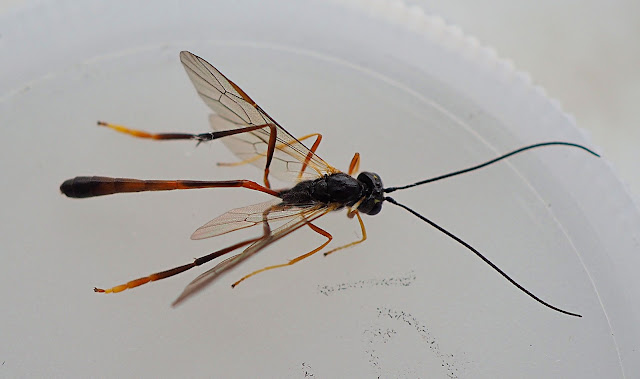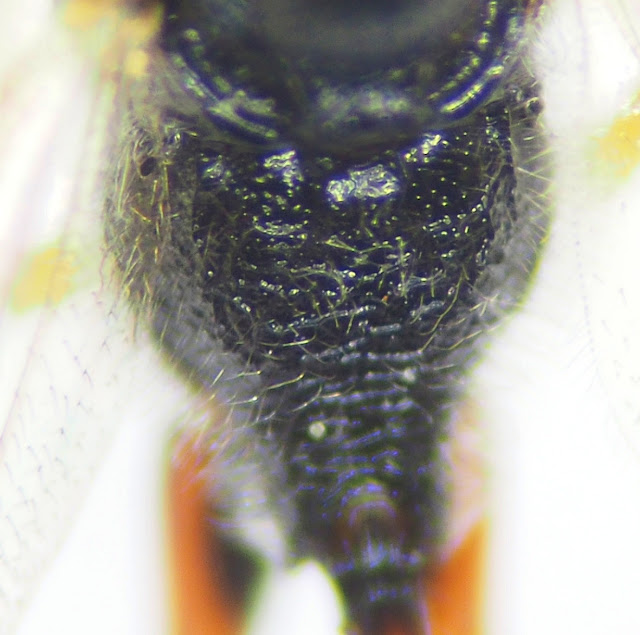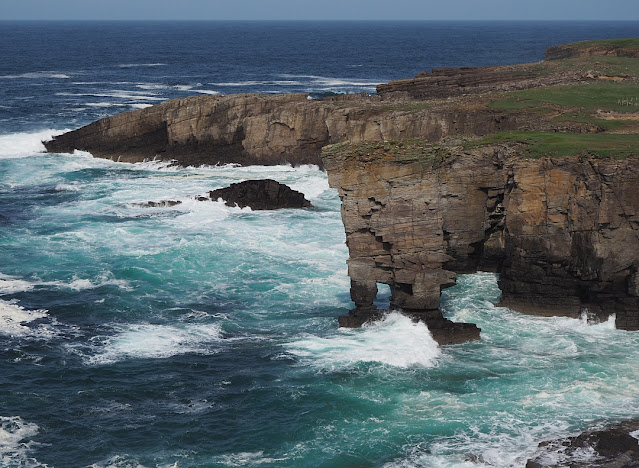I've stopped trying to identify the Campopleginae that I spent so long on. Happily a more knowledgeable and experienced entomologist has taken them on (thank you AG). I've stopped because getting to a more definite identification requires experience with the family, which I don't have. The literature available can no longer guide me to an answer. But, I learned so much of the terminology and morphology that I could move on quickly to that next specimen and identify it.
 |
Agrypon flaveolatum, male.
|
The shape is typical of the Anomaloninae. And this common species keys out relatively easily.
The photography using the EM5-11, 30mm macro and holding it to the microscope eyepiece is improving. Open the aperture, f3.5 is good; get enough light and as fast a shutter speed as you can; avoid noise by keeping the iso to around 500 or so. Using ethyl acetate to subdue or kill specimens is far better than using the freezer as the ethyl acetate keeps them supple. Ichneumons are pretty resilient so they can be stunned for quite long periods using this chemical (thanks for the tip MS). However, ethyl acetate dissolves some plastics so use glass jars. Best to set up a larger, wide necked, shallow jar with absorbent material in the bottom, a lid on top of that and then a small specimen pot to sit on the lid.
 |
Face, clypeus, palps of the A. flaveolatum.
|
 |
Propodeum (apical end of the thorax dorsally), showing the typical "disorganised" carinae of this species.
|
 |
Teeth and front coxae, the coxae lack carinae (ridges).
|
The images are manipulated in Photoscape X which is free software. I guess I could probably do better with Adobe but it's expensive stuff.
Anyway, the learning on the Campopleginae was usefully employed. I've got three more animals to address now, all from the garden.
 |
Ichneumon sp I think, possibly suspiciosus but I need to compare the tarsi with my images of stramentarsus. This one seems to lack a white spot on T4.
|
The moth trapping has not produced anything of interest, but I did find this Monopis laevigella on the garage floor.
 |
Monopis laevigella.
|
A wander up on the moor located the usual Green Dock Beetles and also Heather Beetle which I haven't seen for a while.
 |
Gastrophysa viridula, female top, male above.
|
 |
Lochmeae suturalis.
|
I sometimes comment and offer identifications in Facebook Groups, particularly in our local entomological group. An interesting looking beetle popped up the other day, something unfamiliar to me. I quickly looked at my usual sources, noticed that nationally a particular species was being found and offered an ID. Fortunately I did hedge my bets a bit, because I got it wrong. I wasn't far away but a bit more attention to detail would have helped; less haste, more speed. I should have learned my lesson the previous day when I did exactly the same with an unfamiliar moth. No harm done, useful discussions came out of these two occasions, but with a bit more care and thought I'd have IDed these correctly. With any identification the answer and certainty lies in the detail. (Ok jizz IDs don't, but that doesn't really work with photographs.)
Bird flu still seems to be around. Following on from the previously mentioned Herring Gull and Cormorant there was a dead large gull near Skaill, a report of a dead Bonxie on Westray, and a drake Eider in the middle of a field near Birsay. Unusual behaviour seems to be an indicator of bird flu. On the plus side the Gannets at Marwick seem to be ok with the colony continuing to establish. However, there are not many Bonxies around. On a more cheerful note we found this pair of Eider nesting at Yesnaby.
 |
Eider, drake top two, duck on nest I think, bottom.
|
The Spring Squill was flowering in carpets and there were hundreds of Scottish Primrose. We paid homage to the Oyster Plant.
 |
Scottish Primrose.
|
 |
Spring Squill in front of The Castle.
|
 |
Spring Squill.
|
 |
Oyster Plant.
|
 |
The swell was surprisingly high.
|
Today we went to Evie. There were a few Arctic Terns, a Sandwich Tern and three dark phase Arctic Skuas.
 |
Arctic Skua and Sandwich Tern.
|
The target species were somewhat less spectacular. A couple of fungi that infest Viola sp.
 |
Urocystis violae on Dog Violet.
|
 |
Puccinea violae on Dog Violet.
|
Urocystis violae is found only here and at one other site in Orkney. The photo of Puccinea violae was taken at Yesnaby where I'd found it the previous day, but it was located at Evie also. Gripping!
There are some other Hymenopterans but I'll save them for another day, phew!
Louise went to pick rhubarb for pudding but had to abandon the mission when she found the Blackbirds were nesting in the crown of the plant.

























Great posts Al, theyre inspiring if somewhat beyond me! Keep it up!
ReplyDeleteThanks Stewart. The benefit of retirement, I've got some time!
ReplyDelete